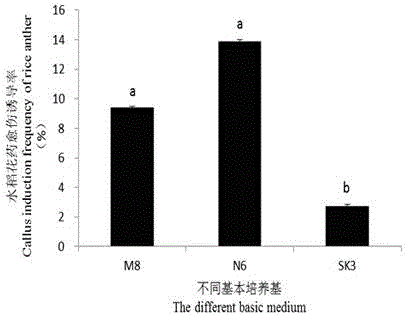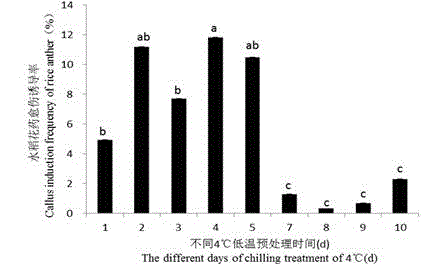Cultivation method of rice germplasm with high-resistant starch and low-amylose starch
A high-resistant starch, low-amylose technology, used in gardening methods, botanical equipment and methods, gardening tools/equipment, etc.
- Summary
- Abstract
- Description
- Claims
- Application Information
AI Technical Summary
Problems solved by technology
Method used
Image
Examples
Embodiment 1
[0031] Example 1 Obtaining F1 of Zhaxima / Nanjing 46
[0032] In May 2011, 500 hybrid F1 seeds were obtained in Nanjing with Zhaxima as the female parent and Nanjing 46 as the male parent. Zhaxima is a local variety in Yunnan. The PS content of its rice was determined to be 8%, which is High RS characteristic germplasm resources; Nanjing 46 is a high-quality and high-yield japonica rice "Wuxiangjing 14" from Jiangsu Academy of Agricultural Sciences as the female parent, and it is crossed with Japanese high-quality japonica rice "Kanto 194", which is a mid-maturing late japonica rice type with high quality and high yield The japonica rice variety has an amylose content of 15% and a yield of 50g / plant.
Embodiment 2
[0033] Example 2 Design of each medium used for F1 of Zhaxima / Nanjing 46
[0034] a) Design of callus induction medium
[0035] The choice of basic medium:
[0036] Select the following components: white sugar 6%, agar strip 8g / L, additional 2,4-dichlorophenoxyacetic acid 1-3.0 mg / L, naphthalene acetic acid 0.5-3.0 mg / L, kinetin 0.2-0.3 mg / L , set two white granulated sugar concentrations of 30 g / L and 60 g / L, and take them respectively with M8, N6 and SK3’s macroelements, microelements, organic components and iron salt components as basic components to form six groups to form anthers Callus induction medium.
[0037] Each of the above-mentioned media was adjusted to pH 5.9 with sodium hydroxide and hydrochloric acid before autoclaving.
[0038] The F1 generation of hybrid rice (provided by Example 1, the same below)
[0039] experiment method:
[0040] In March 2012, the rice panicles at the mononuclear stage of the test were taken. After 1-10 days of low-temperature...
Embodiment 3
[0080] Example 3 Anther induced callus
[0081] Callus induction medium (provided by the best protocol of Example 2)
[0082] Take the single-nucleus flower spikes at the marginal stage of F1 hybrids, take the flag leaves and extract 0.5-1 cm flower spikes, put them in plastic bags after being sterilized with 75% ethanol, and take out the rice spikes after 3 days of low temperature pretreatment. The anther inoculation operations were all carried out under aseptic conditions on an ultra-clean workbench: the surface was first sterilized with 75% ethanol, and the outer sheath of the rice ears was removed and placed in a sterilized Erlenmeyer flask. Disinfect with 75% ethanol for 5 min, and then with 0.1% HgCl 2 Disinfect for 15 minutes and then rinse with sterile water for 3 times, cut off the husks of the sterilized rice ears, align the incisioned husks with the mouth of the triangular bottle with tweezers, and knock them into different anthers to heal the wounds. In the Erl...
PUM
 Login to View More
Login to View More Abstract
Description
Claims
Application Information
 Login to View More
Login to View More - R&D Engineer
- R&D Manager
- IP Professional
- Industry Leading Data Capabilities
- Powerful AI technology
- Patent DNA Extraction
Browse by: Latest US Patents, China's latest patents, Technical Efficacy Thesaurus, Application Domain, Technology Topic, Popular Technical Reports.
© 2024 PatSnap. All rights reserved.Legal|Privacy policy|Modern Slavery Act Transparency Statement|Sitemap|About US| Contact US: help@patsnap.com










